杨丽论文
- 格式:doc
- 大小:413.50 KB
- 文档页数:49
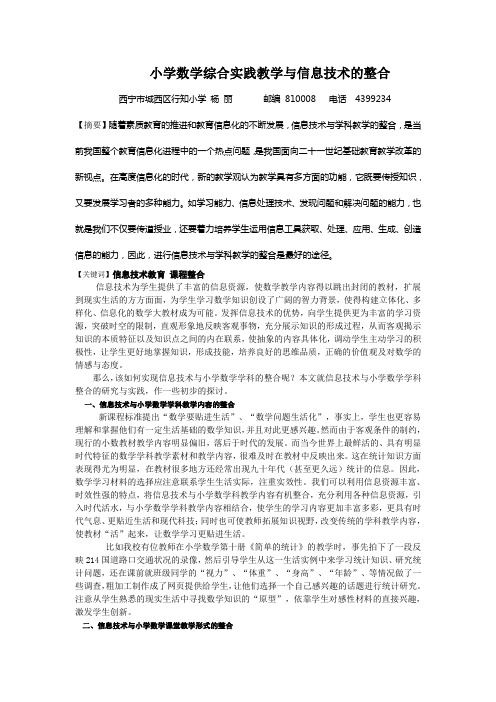
小学数学综合实践教学与信息技术的整合西宁市城西区行知小学杨丽邮编 810008 电话 4399234【摘要】随着素质教育的推进和教育信息化的不断发展,信息技术与学科教学的整合,是当前我国整个教育信息化进程中的一个热点问题,是我国面向二十一世纪基础教育教学改革的新视点。
在高度信息化的时代,新的教学观认为教学具有多方面的功能,它既要传授知识,又要发展学习者的多种能力。
如学习能力、信息处理技术、发现问题和解决问题的能力,也就是我们不仅要传道授业,还要着力培养学生运用信息工具获取、处理、应用、生成、创造信息的能力,因此,进行信息技术与学科教学的整合是最好的途径。
【关键词】信息技术教育课程整合信息技术为学生提供了丰富的信息资源,使数学教学内容得以跳出封闭的教材,扩展到现实生活的方方面面,为学生学习数学知识创设了广阔的智力背景,使得构建立体化、多样化、信息化的数学大教材成为可能。
发挥信息技术的优势,向学生提供更为丰富的学习资源,突破时空的限制,直观形象地反映客观事物,充分展示知识的形成过程,从而客观揭示知识的本质特征以及知识点之间的内在联系,使抽象的内容具体化,调动学生主动学习的积极性,让学生更好地掌握知识,形成技能,培养良好的思维品质,正确的价值观及对数学的情感与态度。
那么,该如何实现信息技术与小学数学学科的整合呢?本文就信息技术与小学数学学科整合的研究与实践,作一些初步的探讨。
一、信息技术与小学数学学科教学内容的整合新课程标准提出“数学要贴进生活”、“数学问题生活化”,事实上,学生也更容易理解和掌握他们有一定生活基础的数学知识,并且对此更感兴趣。
然而由于客观条件的制约,现行的小数教材教学内容明显偏旧,落后于时代的发展。
而当今世界上最鲜活的、具有明显时代特征的数学学科教学素材和教学内容,很难及时在教材中反映出来。
这在统计知识方面表现得尤为明显,在教材很多地方还经常出现九十年代(甚至更久远)统计的信息。
因此,数学学习材料的选择应注意联系学生生活实际,注重实效性。
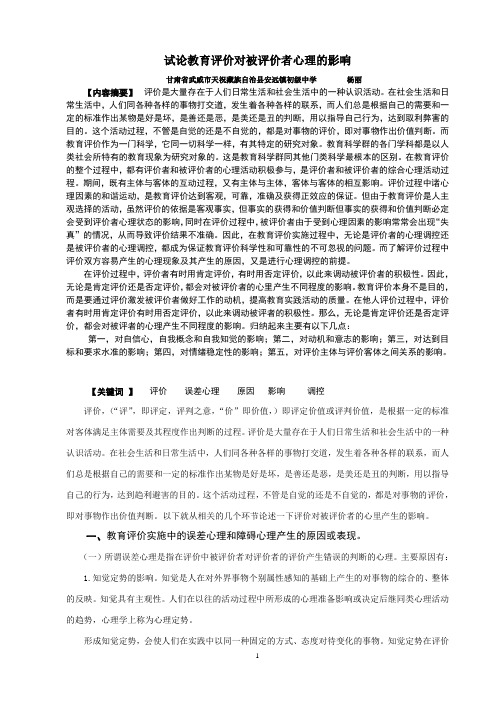
试论教育评价对被评价者心理的影响甘肃省武威市天祝藏族自治县安远镇初级中学杨丽【内容摘要】评价是大量存在于人们日常生活和社会生活中的一种认识活动。
在社会生活和日常生活中,人们同各种各样的事物打交道,发生着各种各样的联系,而人们总是根据自己的需要和一定的标准作出某物是好是坏,是善还是恶,是美还是丑的判断,用以指导自己行为,达到取利弊害的目的。
这个活动过程,不管是自觉的还是不自觉的,都是对事物的评价,即对事物作出价值判断。
而教育评价作为一门科学,它同一切科学一样,有其特定的研究对象。
教育科学群的各门学科都是以人类社会所特有的教育现象为研究对象的。
这是教育科学群同其他门类科学最根本的区别。
在教育评价的整个过程中,都有评价者和被评价者的心理活动积极参与,是评价者和被评价者的综合心理活动过程。
期间,既有主体与客体的互动过程,又有主体与主体,客体与客体的相互影响。
评价过程中诸心理因素的和谐运动,是教育评价达到客观,可靠,准确及获得正效应的保证。
但由于教育评价是人主观选择的活动,虽然评价的依据是客观事实,但事实的获得和价值判断但事实的获得和价值判断必定会受到评价者心理状态的影响,同时在评价过程中,被评价者由于受到心理因素的影响常常会出现“失真”的情况,从而导致评价结果不准确。
因此,在教育评价实施过程中,无论是评价者的心理调控还是被评价者的心理调控,都成为保证教育评价科学性和可靠性的不可忽视的问题。
而了解评价过程中评价双方容易产生的心理现象及其产生的原因,又是进行心理调控的前提。
在评价过程中,评价者有时用肯定评价,有时用否定评价,以此来调动被评价者的积极性。
因此,无论是肯定评价还是否定评价,都会对被评价者的心里产生不同程度的影响。
教育评价本身不是目的,而是要通过评价激发被评价者做好工作的动机,提高教育实践活动的质量。
在他人评价过程中,评价者有时用肯定评价有时用否定评价,以此来调动被评者的积极性。
那么,无论是肯定评价还是否定评价,都会对被评者的心理产生不同程度的影响。

杨丽,杨俊玲(天津工业大学材料化工学院,天津300160)摘要:介绍了研究阻燃纤维的意义、目前阻燃纤维的品种和特种阻燃纤维(偏氯纶和腈氯纶及维氯纶)的性能、用途,并对常见的阻燃涤纶及其阻燃剂进行了表述.关键词:阻燃;纤维;纺织品;应用中图分类号:TQ314.24+8文献标识码:A文章编号:1004-0439(2006)09-0005-03阻燃纤维及应用Flame-retardantfibersandtheirapplicationsYANGLi,YANGJun-ling(Mater.Chem.Eng.Inst.,TianjinPolytechn.Univ.,Tianjin300160,China)Abstract:Thesignificanceoftheflame-retardantfiberresearchesandtheexistentproducts,theproper-tiesandusesofthespecialflame-retardantfiberssuchasvinylchloride-vinylidenechloridecopolymer,acryloni-trile-vinylidenechloridecopolymerandpoly(vinylalcohol-vinylidenechloride)arepresented,andthecommonflame-retardantfibersandflame-retardantagentsaresummarized.Keywords:flameretardant;fibers;textiles;applications收稿日期:2006-01-16作者简介:杨丽(1969-),女,天津市人,实验师,主要从事染整工艺的应用.天然或合成纤维,由于其化学结构的不同其燃烧性亦不一,按燃烧时引燃程度、燃烧速度、息燃性等特征,可将纤维定性地分为阻燃纤维和非阻燃纤维两大类.其中,不燃纤维和难燃纤维属阻燃纤维,可燃纤维和易燃纤维属非阻燃纤维.目前国际上广泛采用限氧指数LOI(LimitOxygenIndex)来表征纤维及其制品的可燃性.限氧指数LOI是指材料点燃后在氧-氮大气里维持燃烧所需要的最低含氧量体积分数.限氧指数LOI值越大,材料燃烧时所需氧的浓度越高,即越难燃烧.通常空气中氧气的体积分数接近20%,所以纤维也可按LOI值分类,将LOI值低于20%称为易燃纤维,20% ̄27%的称为阻燃纤维.[1]为了减少易燃物质的可燃性,约200年前,盖・吕萨克(GayLussac)便研究过生产阻燃织物的可能性.20世纪60年代以前,研究工作重点是粘胶织物的阻燃.开发阻燃合成纤维是近20年的事.因为某些合成纤维在遇火时会熔融收缩而使纤维离开火焰,所以锦纶的阻燃问题一直没有得到重视.后来大量合成纤维同粘胶纤维混纺成织物时,因粘胶纤维易燃,并在织物中有“网格支架”的作用,增加了混纺织物的可燃性.因此,阻燃纤维的研制变得更加重要.随着城市现代化建设的发展,对纺织品的难燃化要求也越来越高.美国曾作过统计,1971 ̄1975年,美国有人伤亡的火灾中,90%以上是住宅火灾,且最初着火物主要是纺织品.近年来,美、英、日、德等国对纺织纤维的阻燃已用法律的形式作了规定,要求凡是制作儿童、老人、残废者的服装,室内铺饰用布,剧院幕布以及交通运输工具和旅馆内使用的纺织材料,炼钢工人及士兵的制服等均需达到一定的阻燃要求.因各种纤维的阻燃性差别很大,同一种纤维的命名亦不同,为了不造成概念上的混乱,采用极限氧指数(LOI)为依据的分类法.表示式如下:对于状态相近的物质来说,氧指数越高,表示在LOI=O2/(O2+N2)×100%印染助剂TEXTILEAUXILIARIESVol.23No.9Sep.2006第23卷第9期2006年9月印染助剂23卷空气中越不容易燃烧,即该物质的阻燃性能越好.[2]这种分类见表1.[3]1偏氯纶偏氯纶亦称偏二氯乙烯纤维,为氯乙烯-偏二氯乙烯的共聚物,其中含氯乙烯30% ̄10%,偏二氯乙烯70% ̄90%,在美国的商品名称为Saran,1940年便实现了工业化生产.[4]偏氯纶聚合物在纺丝时加入少量的液态卤代苯等软化剂以及热稳定剂,用熔纺法纺入空气中,进入冷水(10℃)浴槽冷却,再经过拉伸卷绕即得成品丝.偏氯纶可用熔纺法纺制成鬃丝,也能制得短纤维和长丝.偏氯纶的强度较低,密度达1.70,但具有较好的阻燃性、耐热性和回弹性,还有较高的耐磨性、良好的抗霉和抗腐烂性.65℃以下,在空气中是稳定的,长期太阳光作用下纤维稍变暗;偏氯纶不吸湿,在水中不膨胀,75℃以下能保持满意的机械强度;耐浓酸腐蚀性虽不及氯纶,但在化学纤维中亦可称佼佼者.偏氯纶常用作滤布,对有腐蚀性的液体或气体物质过滤尤为合适.用作鞋垫既能透气,又能保持热量.还能用作纱窗、刷子、手套、袜子、绳缆、捕鱼用具等.偏氯纶的阻燃性突出,可用作车厢中的坐垫材料、沙发套、地毯、防火帘、护林工人制服等.[5]2腈氯纶和阻燃腈纶腈氯纶又称改性腈纶,其纤维大分子链中含35% ̄85%的丙烯腈链节.而阻燃腈纶中的丙烯腈链节量大于85%.阻燃腈纶包括丙烯腈-偏二氯乙烯和丙烯腈-氯乙烯2种共聚纤维.[6]2.1性能腈氯纶原料来源充足,成本低廉,单纤维间有较大的静电,在加工、穿着过程中无擀毡现象,能一直保持蓬松,适宜制造人造毛皮等起毛织物.因阻燃性能好,又适合制造室内铺饰织物.腈氯纶和阻燃腈纶的物理性质、耐候性及染色性类似普通腈纶,而阻燃性、耐化学药品等性能又类似于氯纶.所以,它与多种纤维混纺不会造成染色困难而使织物品质降低,还能赋予织物阻燃性.[7]2.2用途根据人造毛皮加工工艺和毛皮风格的要求,腈氯纶最适合制造人造毛皮,与天然兽皮相比,价廉、兽毛感强、仿天然皮毛形象逼真、质轻、保暖性好.在腈氯纶长毛绒产品中,以仿貂皮、獭皮、狐皮、黄狼皮、灰鼠皮等较为流行,阻燃长毛绒玩具也颇受消费者的青睐,腈氯纶和阻燃腈纶编织物主要用于衣着领域.[8]3维氯纶该纤维于1968年在日本试制成功,定名为SE纤维.化学名是聚乙烯醇-氯乙烯接枝共聚纤维,商品名称叫Cordelan,我国称作维氯纶.目前仅日本兴人公司生产,在美国十分畅销,被认为是一种有发展前途的阻燃纤维.[9]据报道,维氯纶制造方法十分特殊,先在低分子质量聚乙烯醇的水溶液中加入引发剂和氯乙烯单体,使氯乙烯在聚乙烯醇上发生接枝共聚.得到外观为青蓝色的半透明乳状液,随后再混以适量常规聚乙烯醇的水溶液增稠,并经湿法纺丝得到初生纤维,再经拉伸、热处理和缩醛化等加工获得成品纤维.3.1性能①维氯纶的物理性能介于维纶和氯纶之间,软化温度约180 ̄200℃,沸水收缩率在5%左右,手感柔软,白度较好,耐磨性、回弹性以及抗静电性能均属优良;②维氯纶的极限氧指数(LOI)比腈氯纶高,比氯纶稍表1纤维燃烧性的分类纤维名称纤维品种举例LOI/(%)不燃纤维石棉玻璃纤维粘胶纤维17 ̄19棉17 ̄19腈纶18 ̄20丙纶18 ̄20可燃纤维涤纶20 ̄22锦纶20 ̄22阻燃腈纶27 ̄32阻燃丙纶27 ̄31腈氯纶26 ̄31阻燃涤纶28 ̄32聚氯乙烯纤维(氯纶)35 ̄37维氯纶30 ̄33酚醛纤维32 ̄34阻燃纤维聚偏二氯乙烯纤维(偏氯纶)45 ̄48以金属纤维为代表的无机纤维耐热纤维聚四氟乙烯纤维95芳香族聚酰胺纤维33 ̄3469期低;③一般用于室内铺饰用的防火材料,其防火性能均采用发烟量和发热量来表征.维氯纶的温度时间面积因子(t・dθ)为0,是几种纤维中最小的.在相同条件下发热量较小说明它们在燃烧时可抑制纤维分解,而不释出大量的烃类物质以助燃.大量文献报道,合成纤维着火时,人往往是被织物窒息而死.而维氯纶的发烟量仅稍大于粘胶纤维,产生少量烟雾,适用于制造室内铺饰织物,市场前景十分美好;④维氯纶燃烧产生的有害气体为氯化氢.比其他含氯纤维产生的氰化氢的毒性要小.其收缩温度170 ̄180℃,起始分解温度234℃,因此,当接触火焰时仅发生收缩,聚合物徐徐分解,故不会烫伤皮肤.维氯纶的软化温度180℃,熔点不明显,不像锦纶和涤纶熔融后粘在皮肤上产生烫伤.[10]3.2用途可用于织造毯子、床单、罩布等床上用品;妇女儿童衣服、儿童睡衣、老弱病残者的内衣以及工作服衣料;滤布等工业用布;女式兽毛外套、衣服衬里、玩具等绒毛类织物;高级毛巾、墙纸、纸张等非织造物.4阻燃涤纶4.1品种和性能阻燃涤纶制法有共聚法、共混法和纤维阻燃后整理法.以日本东洋纺的阻燃涤纶Heim为例,阻燃涤纶的性能如下:①自熄性优良,符合日本消防法和美国可燃性织物的阻燃标准;②纤维各项物理指标和后加工性能与常规涤纶几乎相同,显示出优良的后加工性能和使用性能;③用分散染料染色时比常规涤纶易染;④燃烧时无毒,不会灼伤人的皮肤.有人曾研究过涤/棉混纺织物的可燃性,结果发现,涤/棉(50/50)织物容易燃烧,即极限氧指数值较低.阻燃整理剂大多以卤素、磷及其化合物为主要成分,较早文献报道的78种阻燃整理剂:含卤素的化合物33种,含磷化合物17种,磷-卤素“配伍”的化合物20种,氮-卤素“配伍”的化合物8种.[11]4.2用途最早的阻燃涤纶用于薄型窗帘纱,原丝78dtex,加捻至800捻/m,用有梭织机制造的织物克重为50 ̄70g/m2.生产厚型窗帘织物,是用165dtex的阻燃涤纶为经纱,腈氯纶为纬纱,经有梭织机织成.交织织物也是床毯、幕布、航空工业中椅子套的装饰材料.棉被、儿童和老人睡衣,特殊防火要求的工作服;阻燃的绳索、缝纫线、帐篷、屏风、工程用布等.5阻燃纤维的发展随着我国阻燃法规的不断健全,阻燃纤维纺织产品开发力度将不断增大,永久阻燃性织物将成为我国纺织品市场的新热点.阻燃涤纶因具有永久阻燃性,其应用前景将十分广阔.主要用途有:产品用纺织品、建筑内装饰材料、防护服等.日本三菱人造丝公司采用非卤素难燃剂,开发出耐候性和难燃性高的聚丙烯(PP)纤维.美国明尼苏打州St.Paul的3M公司最近面市的陶瓷非织造布(专利产品),它在火焰屏蔽用途上有优异的热性能.名为“Ne-xtelFlameStoppingDotPaper”(简称FSDP)的这种产品是薄型且柔性的,当暴露到火中时能保持其完整性并将不会熔化与收缩,在9min内不会烧穿,且有向室内透过的热量较小,没有烟及毒气放出等特点.NextelFS-DP潜在用途包括防火墙、熔炉、燃烧器、管道、绝热材料、密封及阻燃贮藏库等.[12]环境友好型阻燃纤维,纳米级粒径的阻燃剂[13,14],无熔滴阻燃纤维,舒适型阻燃纤维等特殊用途的新型阻燃纤维正在应运而生.[15]参考文献:[1]林山.阻燃纤维[J].上海丝绸,2004(3):26-29.[2]马新安,李新延,王瑄.纯棉织物耐久性阻燃整理的研究[J].陕西纺织,2004,64(4):2-6.[3]LyonsJW.TheChemistryandusesoffireretardants[M].NewYork:W-ileyLuter-science,1970.22.[4]姚穆,周锦芳,黄淑珍,等.纺织材料学[M].北京:中国纺织出版社,1990.104.[5]张梅,孟繁慧.一种轻量吸湿透气功能性保暖内衣的研制开发[J].上海纺织科技,2006,34(1):57-59.[6]邹振光,毛西亭,施楣梧.常规阻燃纤维的技术现状与发展趋势[J].纺织导报,2006(3):45-49.[7]张建春,钟铮.腈氯纶阻燃纤维生产技术与应用[J].纺织导报,2000(2):17.[8]欧育湘.实用阻燃技术[M].北京:化学工业出版社,2002.348-349.[9]全凤玉,纪全,夏延致,等.阻燃粘胶纤维的研究及其进展[J].纺织学报,2004,25(1):121-123.[10]周翠荣,董奎勇,杨萍.阻燃粘胶纤维及其研究现状[J].人造纤维,2004(4):25-26.[11]吴英,翟中凯,郭永林.阻燃涤纶的性能及应用[J].产业用纺织品,2001(1):35-36.[12]高新方.阻燃纤维新发展[J].新纺织,2003(11):21-23.[13]贾修伟.纳米阻燃技术[M].北京:化学工业出版社,2005.570-571.[14]张泽江,冯良荣,邱发礼.纳米无机阻燃剂的研究进展[J].化学进展,2004,16(4):509-516.[15]秦华军,张立新.阻燃剂的现状与发展[J].华北工学院学报,2001,22(2):113-114.杨丽等:阻燃纤维及应用7。
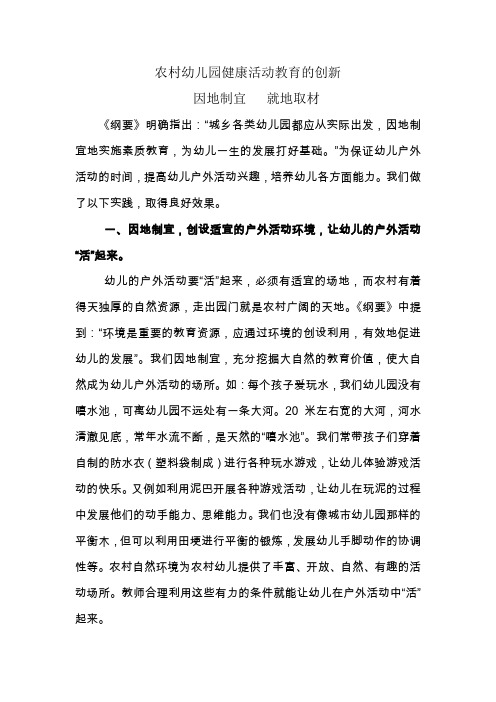
农村幼儿园健康活动教育的创新因地制宜就地取材《纲要》明确指出:“城乡各类幼儿园都应从实际出发,因地制宜地实施素质教育,为幼儿一生的发展打好基础。
”为保证幼儿户外活动的时间,提高幼儿户外活动兴趣,培养幼儿各方面能力。
我们做了以下实践,取得良好效果。
一、因地制宜,创设适宜的户外活动环境,让幼儿的户外活动“活”起来。
幼儿的户外活动要“活”起来,必须有适宜的场地,而农村有着得天独厚的自然资源,走出园门就是农村广阔的天地。
《纲要》中提到:“环境是重要的教育资源,应通过环境的创设利用,有效地促进幼儿的发展”。
我们因地制宜,充分挖掘大自然的教育价值,使大自然成为幼儿户外活动的场所。
如:每个孩子爱玩水,我们幼儿园没有嘻水池,可离幼儿园不远处有一条大河。
20米左右宽的大河,河水清澈见底,常年水流不断,是天然的“嘻水池”。
我们常带孩子们穿着自制的防水衣(塑料袋制成)进行各种玩水游戏,让幼儿体验游戏活动的快乐。
又例如利用泥巴开展各种游戏活动,让幼儿在玩泥的过程中发展他们的动手能力、思维能力。
我们也没有像城市幼儿园那样的平衡木,但可以利用田埂进行平衡的锻炼,发展幼儿手脚动作的协调性等。
农村自然环境为农村幼儿提供了丰富、开放、自然、有趣的活动场所。
教师合理利用这些有力的条件就能让幼儿在户外活动中“活”起来。
二、就地取材,开发利用山区农村自然资源,让幼儿户外活动“动”起来。
幼儿户外活动,少不了要为幼儿提供活动器材。
我们幼儿园周围有着丰富的山区农村资源树木、竹子、农作物··这些资源不仅随手可得,而且幼儿对此比较熟悉。
根据我园实际,我们就地取材,开发山区农村的自然资源,自制了丰富的户外活动器具,建立“人尽其能,物尽其用”的朴素资源观和价值观。
如用竹节做成的小高跷,组织幼儿锻炼身体平衡、手脚协调的能力;竹梯可让幼儿练习钻、爬、攀等能力;用竹竿做成游戏棒,可供幼儿玩接力赛,赶小猪等游戏;用稻草编草垫子摆在地上让幼儿前后滚翻;用稻草编成辫子、绳,把它放在地上作跳跃障碍物,拿在手上作马鞭。
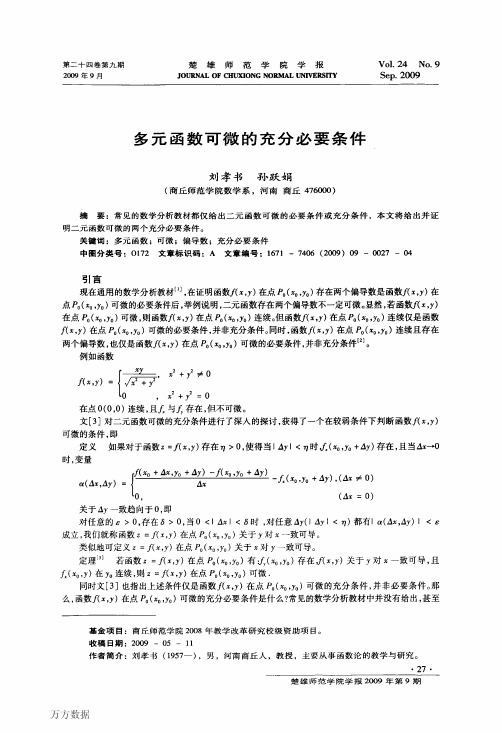
多元函数可微的充分必要条件作者:刘孝书, 孙跃娟, LIU Xiao-shu, SUN Yue-juan作者单位:商丘师范学院数学系,河南,商丘,476000刊名:楚雄师范学院学报英文刊名:JOURNAL OF CHUXIONG NORMAL UNIVERSITY年,卷(期):2009,24(9)被引用次数:0次1.刘玉琏.傅沛仁数学分析讲义 19862.欧阳光中数学分析 19823.刘孝书关于二元函数可微条件的再探讨 2004(02)4.T M 菲赫金哥尔茨微积分学教程 19805.包志清多元函数可微的一个充要条件 2000(02)1.期刊论文杨丽.高俊宇关于多元函数可微的充分条件的再探讨-中国校外教育(理论)2008,""(4)大多数教材都是在较强的条件下讨论了多元函数的可微性的充分条件,这里给出了较弱条件下的多元函数可微的一个新定理的证明及其应用,应用此定理可以判断一些多元函数的可微性.2.期刊论文沐雨芳.MU Yu-fang关于多元函数可微的充分条件的一点改进-泰州职业技术学院学报2006,6(3)各偏导数存在且连续是公认的多元函数可微的充分条件.实际上,此条件可减弱为:各偏导数存在且其中n-1个偏导数连续时,函数仍可微.3.期刊论文刘孝书.孙跃娟.LIU Xiao-shu.SUN Yue-juan多元函数可微的充分必要条件-井冈山学院学报(自然科学版)2009,30(4)常见的数学分析教材都仅给出二元函数可微的必要条件或充分条件,本文将给出并证明二元函数可微的两个充分必要条件.4.期刊论文朱智和.Zhu Zhihe多元函数可微的一个充要条件-绍兴文理学院学报2008,28(10)文章给出了多元函数在一点可微的一个充要条件,可作为现行<高等数学>教材相关内容的一个补充.5.期刊论文陈贞忠反例在多元函数微分学教学中的应用-新乡学院学报(自然科学报)2009,26(6)讨论了反例在数学理论中的特殊作用,并给出了几个在多元函数微分学教学中应用的特例.6.期刊论文蔡协毅多元函数可微条件的一点改进-浙江工商职业技术学院学报2003,2(2)现在各版本高等数学教材均把偏导数fx(x,y)、fx(x,y)在(X0,y0)连续作为f(x,y)在(x0,y0)可微的充分条件.本文认为,这个条件尚可减弱为:z=f(x,y)的其中一个偏导数在(x0,y0)连续,另一个偏导数在(x0,y0)存在,同样使z=f(x,y)在(x0,y0)处可微.对此结论作了证明,并举例加以说明.7.期刊论文康淑瑰.KANG Shu-gui关于多元函数的一致可微性-雁北师范学院学报2002,18(2)本文主要研究了多元函数一致可微与偏导数一致连续的一个关系,即偏导数均一致连续,则函数一致可微.并且给出了函数在无界区域上的一个特征.8.期刊论文刘孝书多元函数可微性的一个注记-南阳师范学院学报2004,3(6)给出了Henle定理的简单证明,并指出该定理n≥3时不真,进而又给出了一个当n≥3时,函数z=f(x1,x2,…,xn)在点M0可微的定理及其证明.9.期刊论文赵树理.刘孝书多元函数可微性的一个注记-纺织高校基础科学学报2004,17(2)给出了Henle定理的简单证明,并指出该定理在n≥3时不再成立,进而又给出了一个当n≥3时,函数z=f(x1,x2,…,xn)在点M0可微的定理及其证明. 10.期刊论文石会萍关于多元函数可微的条件-沧州师范专科学校学报2002,18(3)本文证明了二元函数可微的充分条件并举例验证.本文链接:/Periodical_cxsfxyxb200909008.aspx授权使用:中共汕尾市委党校(zgsw),授权号:1b28d4b3-627e-47af-bf25-9dce00c04937下载时间:2010年8月10日。
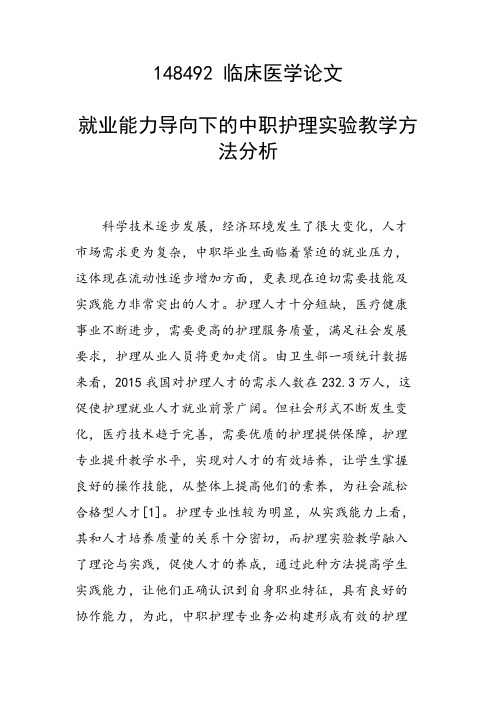
148492 临床医学论文就业能力导向下的中职护理实验教学方法分析科学技术逐步发展,经济环境发生了很大变化,人才市场需求更为复杂,中职毕业生面临着紧迫的就业压力,这体现在流动性逐步增加方面,更表现在迫切需要技能及实践能力非常突出的人才。
护理人才十分短缺,医疗健康事业不断进步,需要更高的护理服务质量,满足社会发展要求,护理从业人员将更加走俏。
由卫生部一项统计数据来看,2015我国对护理人才的需求人数在232.3万人,这促使护理就业人才就业前景广阔。
但社会形式不断发生变化,医疗技术趋于完善,需要优质的护理提供保障,护理专业提升教学水平,实现对人才的有效培养,让学生掌握良好的操作技能,从整体上提高他们的素养,为社会疏松合格型人才[1]。
护理专业性较为明显,从实践能力上看,其和人才培养质量的关系十分密切,而护理实验教学融入了理论与实践,促使人才的养成,通过此种方法提高学生实践能力,让他们正确认识到自身职业特征,具有良好的协作能力,为此,中职护理专业务必构建形成有效的护理实验教学体系,积极探究,生成一套全新的护理实验教学形式,使护理专业学生更好地适应就业,培育全面发展的护理人才[2]。
一、实验教学方法(一)教师主导下的启发式教学法实验教学时,注重多学科之间的交叉及融合。
利用典型案例设计与讨论,发散学生创新思维,让学生大胆提出疑问,分析并解决问题。
如利用高端设备“高级心肺复苏模拟人”模拟各病例情境,学生扮演其中角色,处置病例,针对病例当中常见问题,给出护理方案,分工模拟实施,让学生在体验中进行摸索,提升团队协作及综合应对的能力。
(二)学生主体下的反思式教学法实验实训课教学时,教师重在发散学生思维指导学生观察并分析事物,同时反思问题。
如,护理技能教学在多阶段训练学习中使用教师规范化讲解演示-学生练习?C教师纠错等,特征是以教师讲解为前提,学生多次进行体验训练在训练当中纠正错误总结反思,形成对技能的掌握。
此种方法成效稳固,技能把握比较牢靠。
关于项目时间管理论文时间管理作为项目管理工作中的一个重要组成成分,它与项目的成败,相关企业单位经济利润的取得之间存在很大的关联性。
下面是小编精心推荐的关于项目时间管理论文,希望你能有所感触!关于项目时间管理论文篇一项目管理的时间管理解析摘要:对项目管理的结构框架进行详细的解析以及深入的探究,研究人员发现“与项目有关的时间管理”这一工作内容一方面可以影响项目管理工作的进度规划,另一方面它也可以作为项目管理工作顺利运行的有效方法或者是工具。
总之,本文作者主观的认为,积极的对与项目管理有关的时间管理进行探究工作是极为必要的。
关键词:项目管理;时间管理;解析项目管理作为管理学的一大分支,这一管理工作的落实是在专业知识、技能以及各种科学方法的配合下,对有利资源进行高效的利用,继而在一定的时间期限内达到某种预期结果的目标。
时间管理作为项目管理工作中的一个重要组成成分,它与项目的成败,相关企业单位经济利润的取得之间存在很大的关联性。
本文作者首先解析项目时间管理里的概念,继而详细的论述项目时间管理在企业项目管理工作过程中应用的途径,最后列举与项目时间管理相关的技术与方法以及其发挥的意义,旨在使时间管理为项目管理工作服务的质量实现最大化。
一、浅析项目时间管理的概念项目时间管理实施的目的是为了使某一工程项目如期的完成,这一管理过程是系统性的、连续性的。
依据自己的管理经验,本文作者认为项目时间管理包含的内容是多种多样的,“按照工期、保证项目工程的质量”这是任何一位项目管理者最希望落实的目标,但是纵观项目管理工作的现状,我们能够切实的感触到工期延后等现象频繁的出现,所以对工程项目的时间进行合理的安排与规划在项目管理工作体系中是十分必要的工作内容。
做好项目时间管理这一工作内容,一方面可以使项目如期竣工,另一方面也提高了与项目活动有关资源的利用率,最终达到提高项目管理工作质量的大目标。
二、探究项目时间管理在项目管理工作进程中实施的步骤本文作者认为时间管理的过程可以细化为6个阶段,每一个阶段有涵盖了一个或者多个管理过程。
探讨优质护理在神经内科的实践方法与效果目的分析优质护理在神经内科的应用效果。
方法在我院神经内科进行优质护理活动,转变护理人员的护理观念,强化其基础护理能力,提升护理措施,深化护理内涵,从而提高护理质量和患者满意度。
结果患者对护理的满意度从以往的88%提升到98.2%,每月的护理质量检查以及抽检、病房管理、健康教育、护理安全、基础护理以及医院感染等达标率提升至97.5%目前未出现因护理问题而导致的医疗纠纷。
结论在神经内科实施优质护理可以有效提高护理质量,提升患者对护理的满意度,对患者病情控制也具有较好的价值,可以在其他科室进一步推广。
优质护理;神经内科;护理质量随着环境污染的日益加重以及人们生活需求的扩大,人们对服务质量的要求也随之提高,对于病患来说,护理质量更显得尤为重要。
神经内科病人多为生活不能自理、危重以及年老体弱等患者,临床基础护理以不能满足患者的护理需求,我院神经内科实施优质护理模式,效果斐然,现对其进行总结分析。
1 资料与方法1.1 研究对象选取我院神经内科20名护理人员进行优质护理实践。
护理人员职称:护士8名,护师10名,主管护师2名。
其中专科学历11名,本科学历8名,本科以上学历1名。
同时选取病人40例,对其进行护理研究,其中男21例,女19例,年龄42—81岁,平均年龄52±3.1岁。
1.2 方法1.2.1 氛围营造对20名护理人员进行优质护理护理服务概念、精神、方法进行学习。
之后进行优质护理知识理论考试,同时按照护理人员级别进行护理服务责任状的签订。
将优质护理的服务内容制定成标版挂于护士站1。
在40例患者的床头设立提示牌。
同时还要将优质护理的内容告知患者及家属,争取其护理配合,同时还可以起到监督作用。
每月对护理人员的优质护理能力进行考核,同时对患者进行调查问卷,选取护理服务楷模。
提升护理人员的护理理念,使其真正理解优质护理的意义,从而积极主动的参与到优质护理的实践中去。
职业高中班主任班级管理策略研究优秀获奖科研论文班级合力的形成在于教师尊重学生、关爱学生、善于管理学生,这也是教育工作成功的秘诀所在。
作为班主任,抓好班级管理是带好一个班级的关键。
班主任教育工作的成功与否对班级内学生的成长具有深远的影响。
班主任怎样才能使班级形成合力呢?笔者从如下几个方面谈一下自己的看法。
一、尊重学生,增强班级的感召力有人说,现在的学生难教,职高的老师难当。
笔者却不这么认为。
笔者在和学生们共同学习的时间里,悟出了这样一个道理:只有对学生有一颗尊重之心,处理问题时将心比心,以手足之情去感化引导他们,用信任架起一座与心灵相通的桥梁,才能使学生感到老师的亲切和学校的温暖。
这时候,你就会感受到学生听话了,老师当得也顺溜了。
目前的现实情况是来职高读书的学生大多是在各中学里对学习失去了兴趣的学生,家长对这些孩子也不抱什么希望了。
但作为教师却不能这么想,无论如何都得让他们在学校里学到知识。
经过摸底调查,笔者琢磨出了一套专门教育职高学生的办法,笔者找出一些学生作为以两头带中间的“典型”。
放学后,笔者把他们单独留下来,耐心地给他们辅导当天的功课。
从树立学生的自信心的角度考虑,笔者特地把明天要提问的内容交代一番,提醒他们回家以后要复习,准备回答问题,第二天的课堂上在个别提问时重点提问他们。
经过努力,学生们终于有了进步,在班级里也形成了一股积极向上潮流。
在多年的班主任工作中,我坚持认为:教师做工作需要像团火,上面的小技巧说明,抓住了学生的心,就能够激起学生求学的欲望。
教师要用明确的目标去牵引,用自己端庄的仪表、得体的举止感化学生的行为,稳住学生的神,使学生摆脱自卑,克服破罐破摔的心态;教师要努力塑造完美形象,要用心灵的交流去凝聚,用自己的品格和真诚的情感塑造学生的灵魂,鼓起学生的劲头,使学生掌握所选修的专业技能,靠师生的合力撑开学生积极向上的风帆。
二、关爱学生,增强班级的向心力这些年来,笔者和学生进行过上万次的电话交流,每一次交流都是朋友式的。
安庆市教育教学研究室文件(1)安庆市教育教学研究室文件教研[2009]17 号关于公布 2009 年安庆市学科教学论文评审结果的通知各县(市、区)教研室、市直各中学(民办中学):根据有关规定,结合评审条件,我们组织有关专家对各学科的论文进行了认真的评审。
评审活动已于 8 月底全部结束。
现将各科评审结果公布如下:附: 2009年安庆市学科教学论文评审结果安庆市教育教学研究室二○○九年九月一日拟稿:学科教研员审稿:操璋签发:孙彦附件:2009 年安庆市学科教学论文评审结果高中语文一等奖(12 篇):徐俊志安庆五中如何打造开放性的高中语文教学刘磊安庆一中浅谈古文字教学法在高中文言文教学中的运用胡小艳枞阳县浮山中学朗读与文言文教学刘昶枞阳县汤沟中学略谈中学语文教学模式的创新朱东升怀宁中学两岸花开河水奔流——浅谈语文课堂教学的审美教育葛徐栋潜山县野寨中学导入文本导出情境——如何设计有创意的导语石学军宿松县程集中学建构情感化语文课堂机制的设想徐胜和太湖县职教中心让笔端流淌出动人的乐章方轶婷桐城五中得法于课内得益于课外姚芳桐城五中培养高中生自主性阅读能力江晟望江二中望江县2008年初中毕业学业考试语文试卷分析程千里岳西县店前中学浅议“重复”在语文教学中的作用二等奖(36 篇):章小平安庆八中大题可小作小中能见大徐明安庆九中声声相应音音关情吴慧安庆三中怎样引领学生走进寻美旅途周泉安庆三中古为今用推陈出新——浅谈古诗文教学之联系实际丁大志安庆市广圩高中一千个读者就有一千个哈姆雷特叶明忠安庆市田家炳中学高三复习课中如何做好试卷评讲余宏平安庆市田家炳中学抚红叶而赏秋——诗歌教学要抓意象陈莉芬安庆市杨桥高中错误的教学思考——关于《错误》的教学思考汪慧琴安庆五中情在诗中功在诗外——提高诗歌教学效果的途径王素琳枞阳县白云中学嘈嘈切切错杂弹大珠小珠落玉盘汪五平枞阳县横埠中学拥有迷人的“眼睛”张文得枞阳县会宫中学对中学作文教学的再认识左义泽枞阳县其林中学书读百遍其义自见章颂九枞阳县周潭中学愿书声琅琅不再是旧梦重温李国平怀宁县高河中学作文教学如何培养学生的创新思维何永胜怀宁县新安中学莫为浮云遮望眼——浅谈如何指导学生读懂古诗词施云贵潜山二中新课程下“合作学习”浅探洪全生潜山县野寨中学兴趣是最好的老师——如何提高学生学习语文的兴趣左文政潜山中学高中写作教学中学生思维能力的培养石木火宿松县花凉中学高中语文学习方法指导邵欣宿松县华阳河中学让阅读与写作共舞吕启敏太湖二中返朴归真——让语文教学充满魅力陈金海太湖县北中高中略谈提升学生语文素养的途径胡松华太湖县弥陀高中重视教学反思提高语文教学质量许文祥桐城八中“普通高中课程标准实验教科书”课后练习革新的探讨程军升桐城市天城中学合理处理备课的广度与深度雷丽萍桐城市天城中学浅谈新材料作文的审题和立意吴菲菲桐城市天城中学在语文教学中渗透生活体验之我见姚雄根桐城五中教育意义的探寻方震眩桐城中学催开花朵的才是春风张付红桐城中学课堂教学要浅入深出檀新环望江县高士中学高考语文探究题答题技巧初探虞珍望江县望江中学新课标下的语文情感教学郑建平望江县鸦滩中学浅谈语文教学与学生个性的培养王庆锋岳西县店前中学高中作文的教、学余晓敏岳西县汤池中学高中文言文教学优化策略初探三等奖(72 篇):罗玉红安庆二中语文的素备与个性化教学王莉安庆九中在高中语文课教学中“表演教学法” 的运用杨丽安庆三中《我有一个梦想》教学设计案例江海燕安庆石化一中尽情地聆听尽情地歌唱梁燕安庆石化一中浅论在课堂实践中如何训练说话能力卢大艳安庆石化一中平等对话精神下的动态语文教学谢小苇安庆石化一中由孔子的批评引发的联想朱莉安庆石化一中巧选切入点,激活语文课堂教学邓奇兵安庆市白泽湖中学浅谈文言虚词易混义项辨析李芬安庆市白泽湖中学莫因浮云遮望眼——浅谈高考探究题对语文课堂教学的影响陈琳安庆市田家炳中学以情破课快乐学习陈国平安庆市田家炳中学浅探如何提高高中语文课堂教学的效率李春洁安庆市杨桥高中让写作与阅读比翼齐飞王小强安庆田家炳中学新课标下语文学习笔记的验证性解读王满云安庆外国语学校浅谈建构主义学习论在高中语文教学中的应用凌虹安庆一中用心品味,语文公开课本来有滋有味徐艺荣安庆一中你本来就很美——浅谈高中语文课堂教学的语言艺术汪玉芹枞阳三中让生成之光照亮语文课堂周智刚枞阳三中新课改下文言文教学的一点思考王宝元枞阳县横埠中学带着“镣铐”跳舞吴信原枞阳县横埠中学浅议教案反思及需要注意的几个问题朱旦生枞阳县横埠中学历久弥新泽被万世黄二平枞阳县会宫中学润物细无声——情趣化的语文教学初探刘才友枞阳县汤沟中学新课标高中语文课堂教学的三重意识周俊枞阳县周潭中学高考古诗词鉴赏浅析周七林枞阳县周潭中学浅谈语文课堂教学中创设情境的方法丁君怀宁县新安中学拨开杨修之死疑云——聪明反被聪明误朱志亭怀宁县新安中学有效讨论催生高效课堂胡佐焰潜山二中采取有效教学形式提高师生互动效能李俊生潜山县黄铺中学如何在诗词教学中渗透人生观与价值观张世旺潜山县黄铺中学摆脱应式语文教学课堂呼唤美育目标江张松潜山县天柱山学校《孔雀东南飞(并序)》研究性学习的思考徐燕玲潜山县天柱山学校这堂课,你准备如何导入?程朝霞潜山县职教中心一首感伤凄清的婉歌——漫谈戴望舒《雨巷》的艺术风格周火明宿松二中紧扣《考纲》立足文本提高考技贺丽华宿松县程集中学创设适合中学生阅读的环境齐新娣宿松县程集中学有备无患,让我们的课堂教学灵动起来吴习林宿松县程集中学快乐,作文教学的永远追求陈咏梅宿松县花凉中学润物细无声董少林宿松县花凉中学绽放思维之花结出创新之果金海兵宿松县许岭职中试论在语文教学中渗透心理健康教育黄敦乔太湖二中全面把握科学应对舒福荣太湖二中把握时代脉搏提升专业素养陈文乔太湖县弥陀高中情感是语文教学的灵魂何洪霞太湖县弥陀高中高中作文教学方法摭谈孙政太湖县弥陀高中语文教育在校园文化建设中的意义杨升太湖县朴初中学语文教育之树永葆繁茂张云太湖县朴初中学让语文课堂多一些幽默刘文芳太湖县职教中心“美”在诗歌教学中光银华桐城八中循形入境依象明情方茂桐城二中摭谈古典诗词鉴赏中的“炼字”问题陈朝晖桐城九中当前语文教学困境之思考秦雪峰桐城六中激发学习兴趣培养创造思维许传明桐城七中确定目标整合提升李小飞桐城十中语文教学要放飞学生想象的翅膀李春霞桐城市天城中学语文教学要引导学生自主快乐学习潘新征桐城市天城中学浅谈诗词教学与学生人文素养的提升汪林利桐城市天城中学摭谈边塞诗的鉴赏汪小勇桐城市天城中学让美育渗透到高中语文教学中张宏亮桐城市天城中学石韫玉而山晖水怀珠而川媚——作文之语言锤炼周兴广桐城中学论王安忆小说童学斌望江三中巧设过程目标,构建三维思考汪德元望江县高士中学构建高三语文生命课堂张结娥望江县赛口中学浅谈点拨教学张师栋望江县赛口中学课谈李商隐诗的魅力徐向阳望江县太慈中学普通高中学生作文弊病分析与矫治对策戴飞望江县鸦滩中学深处种菱浅种稻剪裁妙处非刀尺——谈谈如何使高考作文内容更充实范春梅望江中学试论语文学困生转化策略胡开霞望江中学唐诗双峰风骚各领——李白﹑杜甫诗歌比较鉴赏储晓明岳西县汤池中学以平和的心态看待骂老师的高考作文汪瑞华岳西县职教中心浅谈如何提高职业中学的语文教学质量汪水云岳西中学高中语文教学应激活学生主体意识高中数学一等奖(11 篇):韩育春望江二中高中数学课堂教学中创新能力培养初探韩可志安庆十中 2009年安徽高考数学新课标卷考试说明解读开凯天城中学探讨新课程背景下如何进行课堂教学徐舒曼潜山中学培养学生能力,提高教学质量罗巧莲宿松程集中学形象思维在数学教学中的应用吴约中枞阳浮山中学探索·拓展·思考·提炼王志强怀宁中学设境激趣探知求真——浅谈新课程理念下的概念课教学苏深强太湖朴初中学数学课后作业之我见张朝阳岳西县汤池中学感悟“独立性检验的基本思想及其初步应用”施利国安庆市二中新课标下数学创造性思维的培养韩琳安庆二中数学教学中如何引导学生反思二等奖(42 篇):詹德海市区高一学生应掌握的数学思想方法王庆市区幽默诗意动态杨莉市区循环结构吴根福市区浅谈人教A版《普通高中课程标准实验教科书·数学》陆克彬市区 VB程序在绘制数学函数图像教学中的尝试陈贤清市区看学生的解题报告,探促进学生积极思维的若干策略徐冬林市区对新课标准理念下高中数学作业设计与批改的思考和实践鲍成航市区数学新课程教学中建构主义实施的若干思考王毛霞望江县谈青年教师成长的几点思考王立文望江县《发挥学生的主观能动性》——让学生自己学会提出问题张玉琴望江县高中学生数学思维障碍的成因及突破陈文平望江县《<数列>教与学中的困惑及反思》——一份来自学生的调查报告虞爱斌望江县新课程——信息、图表和形的重要性童云鹏望江县新课改下的高中数学教学反思张先胜桐城市新课标下如何认识数学课堂教学的点滴体会胡维秀桐城市新课程理念下的数学课堂教学误区杨月香桐城市立足课本教学——高中数学新教材教学心得丁西平桐城市浅谈新课程背景下课堂教学评价体系的建构汪文伊潜山县如何让《几何画版》更好地走进中学课堂李远飞潜山县浅谈关于计算机辅助数学教学凌红霞潜山县浅谈如何培养中学生数学应用能力左伟旺枞阳县教以致学学以致用吴利华枞阳县浅谈新课标下的数学课堂教学王远德枞阳县浅谈新课改下提高创新能力与培养学习兴趣的有机结合王进年枞阳县数学教学中创新思维的培养方光明枞阳县浅谈数学思维能力的培养王华枞阳县新课标下创新思维的培养周胜枞阳县激发兴趣,夯实基础,提高能力吴宜苗枞阳县严密细致深刻——分类讨论思想夏令宏宿松县浅谈“以学生为主体”的教学策略陈洪文宿松县浅析数学差生的成因及应对策略许红兵宿松县浅谈如何突破解析几何的运算关吴亚东宿松县“学法指导”让学生在自觉中学习唐华松宿松县也谈新课程标准下学生数学学习方式的转变陈民国宿松县用“数学实验”寻求解题的突破口胡伟怀宁县函数定义域教学浅探章璐怀宁县新课程标准下数学课堂教学的几点体会周志宽太湖新目标新教法——谈新课改下的初中数学课堂教学李叶生太湖浅析探究式教学余娟娟岳西县浅谈高中生的数学思维障碍胡善雷岳西县新课改离不开老方法王华标岳西县浅析向量的数量集在几何中的应用三等奖(45 篇):杨大勤市区用心做教育张顺市区高一学生数学学习现状分析及对策芦盈盈市区高中数学教学中应注意的几个问题陶敏市区浅谈复数问题的几种解法陈百亮市区二次函数在闭区间上的最值问题喻昀昀市区浅议如何针对不同层次学生设置问题情境孙莹市区优化课堂教学提高备课效率孙南枝望江县自然状态下的数学教学陈结群望江县新课程下学生自主学习能力的培养邹胜金望江县高中数学研究性学习再认识曹文昭望江县在应用问题教学中的一些想法吴姣珍望江县关于提高数学课程的课堂效率的几点心得周智龙望江县现代教学技术与高中数学教学姚国凡桐城市培养学生的数学创新意识之我见程忠桐城市新高考下高三数学复习工作的点滴体会叶辉桐城市立足课堂教学培养探究能力程向前桐城市浅谈高中数学多媒体教学张神州桐城市浅谈新课程改革下的数学教学汪朱伟潜山县转变教学观念,探求新教材《算法》教学孙灿潜山县如何在数学课中实施研究性学习张小星潜山县新课改下如何激发学生学习数学的兴趣陈建兵枞阳县感受数学美,激发学习数学的乐趣何志刚枞阳县中学数学课堂中问题引入方法剖析陈大志枞阳县仁者见仁,智者见智何朝华枞阳县浅谈如何引导学生主动参与数学课堂教学吴淑芳宿松县注意初、高中数学衔接提高高中数学教学质量祝沛宿松县浅谈新课程教学中如何引导学生自主学习陈芳宿松县如何引导学生写数学日记董玉兰宿松县浅谈新教材中的类比思想吴陈飞宿松县利用空间向量求角应注意角的范围汪金华宿松县遇到障碍调整视角独辟蹊径杨润平宿松县类比思想在高中数学教学中的渗透祝和香宿松县学指数函数不应忽略的三个问题朱华平怀宁县新课程理念下数学教学的备课工作朱良茂太湖县浅谈数学教学中学生学习兴趣的培养朱晓兰太湖县浅谈数学教学中问题情境的创设罗华根太湖县向量在高中数学中的地位及作用徐波太湖县关于提高数学课堂教学效益的几点思考方金洋太湖县在新课标下如何多快多好省地把握图像命脉何哲红太湖县数形结合思想解题初探张松云太湖县“目标教学”中的“导学”初探夏金华岳西县浅谈文科数学教学邬胜才岳西县如何让高一新生尽快适应高中数学的学习张辉岳西县整合高中数学与信息技术提高课堂教学效益胡淑芳岳西县新课标下数学习题课的教学高中外语一等奖(12 篇):何孙香安庆十中高二学生如何逐步适应英语新题型——任务型读写江霞安庆十中横看成岭侧成峰变化可测有其宗——谈2009年高三英语复习策略江雄风安庆十一中幽默在中学语法教学中的运用操动春怀宁中学尝实求真寓德于教——论英语教学的德育功能唐润枞阳三中如何做好初、高中英语教学的衔接刘来娥宿松程集中学农村高中生英语写作现状与对策刘同美潜山官庄职中高中英语导入技巧余娟望江雅滩中学浅谈高中英语学法指导禇昕涛岳西汤池中学科学高效记忆学好高中英语黄家合太湖弥陀中学为师八忌余小庆望江中学直面要素简化教学林志红桐城五中高中生英语写作存在的问题与对策研究二等奖(48 篇):洪志杰安庆二中新课标下的课堂教学刘江安庆二中任务型读写特点及突破策略初探郭凤安庆二中解读2009年安徽省高考英语新增题型之任务型读写题郜阳旭安庆九中安庆市2008-2009学年度第一学期高一期末考试英语试卷分析慈曾美安庆七中浅谈高中英语听说的现状和应对刘芳安庆十一中试论高中英语阅读能力的提高赵欣石化一中整体式教学思想在高中英语词汇教学中的运用严朝晖广圩中学浅谈英语教学中如何发挥学生的主体作用张剑敏广圩中学扬长避短长善救失孙瑾安庆龙门高中如何做“任务型阅读”吴兴旺枞阳浮山中学浅谈如何提高学生阅读能力及写作能力张慕查枞阳浮山中学如何提升高中生的英语写作水平陈志力枞阳横埠中学如何提高农村中学生英语听说能力王爱芳枞阳其林中学浅谈中学生语法教学唐传毅枞阳周潭中学新课程英语课堂教学按探邵七林怀宁中学浅谈新课标中英语法教学方法陈节怀宁中学“细点”之处见真章汪春梅怀宁新安中学高中英语教学未来走向的几点认识叶六一怀宁新安中学英语教学与文化交际王丽娟怀宁高河中学新趋势下高三英语复习周夏芳宿松二中怎样上好高中第一堂英语课吴胜旺宿松程集中学让英语课外活动“活”起来刘家月宿松程集中学高三英语第二轮复习之我见余持恒宿松程集中学在阅读训练中怎样提高泛读能力项泽志宿松二中从比较中西文化中学习汪徐平潜山王河职中浅谈英语教学中的跨文化交际能力的培养张琼潜山黄铺中学浅谈新课改下的备课徐素安潜山中学结合教学实际,优化课时目标黄桂生潜山中学新课标下英语课文教学浅议聂小金潜山黄铺中学评析英语教学中的重要环节王黎明岳西店前中学英语教学中应渗透情商教育储诚铁岳西汤池中学以阅读课为阵地攻克口语关章玲太湖职教中心将课堂还给学生,让英语课活起来朱书德太湖徐桥中学背景知识对翻译的重要性潘琳太湖牛镇中学优化教学策略之英语课堂互动周艳霞太湖弥陀中学任务型课堂教学模式的探索与实践刘林霞太湖弥陀中学灵活多样的课堂举例陈超太湖北中中学北师大版高中英语教材的课堂阅读策略潘春雨望江赛口中学实践中的新教材与教学整合沈行远望江二中不容忽视的高中英语阅读教学张英望江二中复述英语课文提高语言能力肖丰望江二中英语课堂中的情景教学丁仕文望江赛口中学新课改下对传统英语课堂教学的反思宋笑桐城中学高中英语作文训练“55”模式初探向珊桐城五中浅谈高中生英语写作能力的培养与提高彭明桐城十一中谈英语教学中跨文化交际教学的实践徐兆玲桐城二中新课标下教师因素对学生阅读能力的影响叶六一桐城六中新课程标准下“信息网”在英语教学中的运用三等奖(60 篇):叶青安庆二中我思故我在——谈谈新课改环境下的教学反思余雅艳安庆五中论任务型教学模式在高中英语阅读教学中的作用刘丹安庆七中英语教学实质上是交际能力培养陈涛石化一中如何提高学生任务型读写能力梅林白泽湖中学如何在新课程改革中开展高中英语阅读课的教学活动陈小芬广圩中学任务型教学中英语阅读能力的教学策略和反思金高文枞阳横埠中学明晰教学目标,优化课堂效益周红兵枞阳横埠中学浅谈如何提高英语教学效率钱刘中枞阳会宫中学高考英语作文失分分析与应对策略方五三枞阳会宫中学任务型读写设空策略和解题思路查翠红枞阳会宫中学浅谈高中英语教学的心得体会汪满红枞阳汤沟中学浅谈阅读理解解题技巧方水炬枞阳周潭中学高三英语一轮复习阅读教学浅议朱琳怀宁高河中学科学组织教学,提高学生任务型读写能力丁士正怀宁高河中学英语教学中听力能力的培养及应试技巧王叶怀宁洪镇中学对中学英语听力教学的探讨王桂霞怀宁石牌高中英语教学中的语感培养何毓华怀宁石牌高中优化课堂结构提高课堂教学效果杨凤林怀宁石牌高中如何做好英语学习弱势群体的初高中衔接陈永红怀宁秀山中学谈口语教学中跨文化交际能力的增强夏立青怀宁秀山中学新题型新策略康英霞怀宁月山高中谈培养学生的英语听力能力何文波潜山槎水中学浅谈新教材的文化资源胡德辉潜山黄铺中学 About some Basic Principles in Teaching English林雄义潜山黄铺中学浅谈中学英语教学中的素质教育郝祥龙潜山黄铺中学提高农村中学生阅读能力的几点做法黄光灿潜山野寨中学浅谈高考书面表达高分技巧汪翠霞潜山野寨中学如何提高中学生的英语阅读能力的一点探索刘云凤潜山职教中心摆脱单项分析型教学,加强整体综合教学李倩潜山职教中心新课标下教师应掌握的教学技能储昭香潜山中学让学生成为“乐读”者——浅谈英语教学中的阅读引导陈思凤宿松程集中学英语阅读理解能力培养之理论与实践陈凤莲宿松程集中学以农村中学为例,试论新课程背景下高中英语教师素养提高的必要性和对策胡庆华宿松程集中学浅谈如何提高学生英语作文王敬东宿松二中也谈英语教学中后进生的转化方略季必莲宿松二中改进试卷评价方法,提高试卷讲评效果齐娟宿松二中影响初高中英语教学衔接的因素及对策汪周明太湖二中Techniques of English Pronunciation Teaching胡刘旺太湖弥陀中学如何让学生更好的学习英语王华应太湖弥陀中学高三新课标英语总复习的五项原则王文友太湖弥陀中学也谈英语教学中的激励机制胡少鹏太湖弥陀中学在总结中不断进步张怀毅太湖小池中学如何备好新课程标准下的英语课詹丽丽太湖职教中心中西合璧水乳交融程金华太湖职教中心浅谈中职英语教学中的情感教学蒋红杰桐城二中中学英语听力教学中存在的问题和策略丁善央桐城九中谈高中英语课堂导入陶海香桐城天城中学英语阅读教学之我见万玲玲桐城中学任务型教学模式下的英语作业的布置汪向东桐城中学备活高三复习课方丽平望江二中抓好词汇教学轻松学习英语袁结斌望江二中语言示例与情感目标柯银桃望江二中如何确实有效地提高学生英语阅读能力童小苗望江赛口中学合理利用英文报刊指导学生课外阅读鲍光荣望江三中浅谈高中英语如何进行词汇教学詹美云望江雅滩中学语法教学在情境中生成张结根望江中学适应新课改英语口语上台阶胡素琴岳西职教中心高中英语阅读策略探微方玲娟岳西职教中心浅谈如何在高中英语中培养学生的兴趣王红梅岳西职教中心朗读在学习中的作用中学物理一等奖(12 篇):。
Enhancing English vocabulary pronouncing and spelling through the application of “Orthographic Cipher” approach in a Rural Senior One High School“表音密码”教学法在提高农村高一学生英语词汇拼读效率方面的运用中文摘要英语是世界通用语言,目前在全球范围内是使用最多的交际语言,词汇学习是英语学习者学习英语的一个重要的组成部分。
众所周知,正确拼读英语单词是英语词汇学习的重中之重。
有关事实表明,大多数农村高一学生虽然学了五六年英语(小学三年级开始),但他们在英语单词拼读方面依然有很大困难。
毫无疑问,英语单词拼读能力的薄弱,直接阻碍着学生在英语其它方面的学习。
为什么学生不能有效地拼读英语单词?如何改进英语词汇教学,采取更科学有效的教学方法激发学生的积极性和主动性?这个问题一直困扰着笔者。
这是否与英语语音的学习方法和学习策略有关?目前还在农村学校流行的“国际音标”语音教学法是否符合英语文字的本质?语音训练新方法——“表音密码”教学法是否能够提高农村高一学生拼读英语单词的效率?“表音密码”作为一种不同于“国际音标”的语音教学法,也许能更好地适应中学英语教学的要求,能够使学生有效地读写记忆英语单词。
带着这个愿望,笔者开始了这次研究。
首先阐述了词汇教学的的重要性,然后对国内教授英语单词拼读的现状进行了分析,迫切地感到上述问题有必要进行研究。
接着本文通过回顾国内外在学习策略及单词拼读教学方法上的诸多研究,发现各种方法各有优缺点,但都不是从英语文字本质出发,效率低。
因而,笔者针对河南省农村一所高中的一年级学生进行了“表音密码”方法在单词拼读中的运用方面的研究。
论文提出两个假设:㈠“表音密码”语音教学法能够提升农村高一学生的英语单词的拼读能力;㈡英语单词拼读能力的提高能够带动学生在英语其它方面学习能力的提高。
为了验证这些假设,笔者采用河南省某农村中学高一年级两个平行班作为研究对象,一个实验班,一个对照班。
实验班采用“表音密码”教学法训练学生拼读单词,对照班采用“国际音标”教学法训练学生拼读单词。
实验结束后,经过两个班的前后测成绩和问卷数据的spss分析,结果表明受培训的实验班在后测中,假词朗读和拼写测试明显优于对照班;“表音密码”教学法比“国际音标”教学法更能有效提高高一学生的英语单词拼读能力,也证明接受“表音密码”教学法进行培训的学生极大地提升了学习英语的自信心和主动性,从而也在很大程度上带动了学生在英语整体学习能力的提高。
最后,论文总结了本教学实验的阶段性后果,提出了运用“表音密码”教学法进行单词拼读教学的两点建议:1.在学习英语的任何阶段,即使是在已有六年英语学习基础的高中阶段,英语教师都要从英语是表音文字这个本质特点出发,对学生进行“表音密码”方法的训练,提高学生的英语单词拼读能力。
2.教师应该结合实际所用教材,经常性地对学生进行“表音密码”方法的训练,帮助学生更实际有效地学习英语词汇,增加词汇量,为英语学习打下坚实的基础,从而带动学生英语学习的全面提高。
关键词:“表音密码”教学法,英语词汇的拼读能力,农村中学。
AbstractEnglish is the most widely used number one world language. However, too many students in rural areas in China have great difficulty in learning even the most basic elements of the language: vocabulary. As is well known to us all, what is of great significance to leaning English vocabulary is the pronunciation and spelling of each word, and the pronunciation of a word is the basis of the base. During my teaching practice, a great many students in a rural senior one high school still have so many problems in pronouncing and spelling English vocabulary. There is no doubt that the problems badly influence the English learning of a student. The following questions always strike me: why do students often fail in pronouncing and spelling English vocabulary efficiently? What is the effective approach to build up the confidence and motivation of students? Does it relate to their English phonetic learning strategies? Can IPA-international phonetic alphabet approach that is still popular in rural areas assist students in pronouncing and spelling English words efficiently? Can “orthographic cipher”approach enhance rural students‟reading and spelling abilities of English vocabulary?Based on the questions, an investigation was conducted in the application of the “Orthographic Cipher” approach used to teach and learn to pronounce and spell English words. Firstly, the author elaborated the great importance of English vocabulary in Teaching and Learning English; then analyzed the domestic situations in teaching and learning to pronounce and spell English vocabulary and felt that there is critical need for research. Next, the author found that the three approach —the International Phonetic Alphabet approach, the phonics approach and the whole language approach all don‟t reflect th e English nature i.e.a kind of the orthographic language and have low efficiency though they have their own merits. Therefore, the author began the study o f the “Orthographic Cipher” approach used by the senior one students of a rural senior high school in Henan province.Two hypotheses are proposed: ⑴The “orthographic cipher” approach can enhancerural students‟ abilities to read and spell English words; and ⑵ the improved phonetic level can help to re-found interest in English and confidence in themselves in learning this language, thus raising their whole English learning level. In order to validate the assumptions, the author has taken two natural classes of the first graders in senior one high school as the subjects, experimental class and control class. The experimental class was taught to read and spell English words b y the “orthographic cipher” approach while the control class by means of the IPA approach. After three-month experiment, the pre-test and post-test are analyzed. The SPSS analysis shows that students in experimental class who have been trained in the use of the “orthographic cipher” approach performed better in the pseudo word post-test than those in the use of the IPA.The results show that the “orthographic cipher” approach can effectively develop the students‟ ability to pronounce and spell English vocabulary. I also prove that the English reading and spelling ability of the experimental group has increased remarkably over those of the control class; Moreover, it built up the students‟ self-confidence and they would learn English on their own initiative.Finally, the thesis summarizes the achievements of the experiments and sets forth two suggestions on vocabulary teaching from “orthographic cipher” phonetic instruction: First, it is essential that teachers should instruct students in a basic English learning stages in pronouncing and spelling English words by the “orthographic cipher”approach, which reflects the English nature i.e. a kind of alphabetic language.Second, I suggest that teachers should make the best of the present teaching materials to instruct students how to read and spell English words by means of the “orthogr aphic cipher” approach daily. The first thing that we should do as teachers is to help students learn English vocabulary more effectively, acquire as many English words as possible and lay a solid foundation for going on learning English, having a strong influence on the whole English level of the student in our country.Key words: the “orthographic cipher”approach, , pronouncing and spelling of English vocabulary, a rural senior high schoolContentChapter 1 Introduction1.1 The importance of English vocabulary in Teaching and Learning English1.2 The importance of English sounds in teaching and learning to read and spellEnglish vocabulary1.3 The Present Situation of V ocabulary Teaching In A Rural Senior High School1.4 The Statement of the Problem and Need for studyChapter 2 Literature Review2.1 Three Dominant Approaches in Teaching Decoding and Encoding English2.2 The International Phonetic Alphabet Approach2.2.1 Advantages of the International Phonetic Alphabet2.2.2 Disadvantages of the International Phonetic Alphabet2.3 The Phonics Teaching Method2.3.1 Advantages of the Phonics Teaching Method2.3.2 Disadvantages of the Phonics Teaching Method2.4 The Whole Language Teaching Method2.4.1 Advantages of the Whole Language Teaching Method2.4.2 Disadvantages of the Whole Language Teaching Method2.5 New phonetic instruction----- Orthographic Cipher2.5.1 Knowledge about Orthographic Cipher2.5.1.1 26 Letter Names and 26 Letter Sounds2.5.1.2 26 Consonant Letter Sounds and 18 V owel Letter Sounds2.5.1.3 108 Letters and Common Combinations Representing 26 ConsonantLetter Sounds And 18 V owel Sounds2.5.1.4 468 Uninterrupted Sounds2.5.1.5 Common Prefix and Suffix2.5.2The Abilities Of Orthographic Cipher2.5.2.1 Segment Words2.5.2.2 The Location of Stressed Syllable2.5.2.3 The Pronunciation Of Stressed And Unstressed SyllableChapter 3 Research Methodology3.1. Research questions3.2 Subjects3.3 Design of the Study3.3.1 The experiment group: the orthographic cipher method3.3.2 The control group: The IPA Method3.4 Measures of the experimental Procedures3.4.1 Pre-test3.4.2 Post-test3.5 Instruction Processes3.5.1 26 letter names and letter sounds3.5.2 Instruction of the 26 Consonant Letter Sounds3.5.3 Instruction of the 18 V owel Letter Sounds3.5.4 Instruction of 118 Letter and Letter Combinations Representing The 44 Sounds inEnglish3.5.5 Instructions of 468 Uninterrupted Sounds3.5.6 Prefix and Suffix3.5.7 Instruction of the Seven Cipher Abilities3.5.7.1 Segment Words3.5.7.2 The Location of Stressed Syllable3.5.7.3 The Pronunciation of Stressed and Unstressed Syllable3.5.7.4 Application3.5.7.5 RewritingChapter 4 Results and Analyses4.1 Results and Analysis of the Pretest4.2 Results and Analysis of the Posttest4.3 SummaryChapter 5 Conclusion5.1 Major Findings of The study5.2 Pedagogical Implication of the Study5.3 Limitations of the Study and Suggestions for Further ResearchReferencesAppendixⅠ: Knowledge about Orthographic CipherAppendixⅡ: Abilities of Orthographic CipherAppendi xⅢ:Orthographic Cipher Training PretestAppendixⅣPhonetic Training PosttestChapter 1: Introduction1.1 The importance of English vocabulary in Teaching and Learning EnglishLanguage is the instrument through which people communicate with each other. V ocabulary is one of the three elements(phonology, grammar, and vocabulary)of a language. Words constitute a fundamental component of any language; thereby words are of critical importance to language learners. It is also the building material of a language. It is clear enough that without knowledge of words, language learning turn out to be “a castle in the air”(Wilkins,1978). Wilkins also says “Provided one knows the appropriate vocabulary, communicating in a foreign language may not be very difficult; without vocabulary, however, it is next to impossible.”(Wilkins,1978). Carter & McCarthy compared the relative significance of grammar and vocabulary in the processing of negotiating meaning for language learners and drew the conclusi on that “Without grammar, very little can be conveyed, without vocabulary, nothing can be conveyed”(Carter & McCarthy,1990. Just as Harmer says “If we compare language structure as the sketch of language, vocabulary is the thing that provides important org ans as well as blood and flesh”(Harmer,1990)In all, vocabulary is of vital importance in foreign language learning and teaching. Insome sense, language proficiency is depended on the quantity of mastered vocabulary. V ocabulary is the foundation of all language skills and is the rather afflicting part that English learners may come across in the first place. Vocabulary teaching is fundamental and an integral part of language teaching.In learning English, vocabulary acquisition is the main task, it is very important to acquire as many English words as possible. It is well-aware that learning English involves the learning of a large number of English words. In measures the readability of an English text, vocabulary difficulty has consistently been found to be the most significant predictor of overall readability. Moreover, once a vocabulary measure is included in a prediction formula, sentence structure does not add very much to the prediction. In teaching comprehension, the first task is helping students understand what unfamiliar words mean. The second task is helping students remember words or, more precisely, helping them store words, especially content words in memory. A second fact about vocabulary and memory is that form may be more important than meaning in remembering a word item. We rely on the form of a word to lead us to its meaning, for we see or hear a particular …shape‟ and try then to remember what that shape means(Carter & McCarthy1990, p.64)..1.2 The importance of English sounds in teaching and learning to read and spellEnglish vocabularyEnglish is an alphabetic language. As an alphabetical language, its letters should represent the 44 sounds in English. These 44 sounds are both life and soul of English. Whether one can spell an English word correctly is largely decided by whether he or she knows the one hundred or so letters and letter combinations that represent these 44 sounds.As is mentioned above, vocabulary begins with sounds, so phoneme is the foundation of vocabulary. The most important ability is phoneme for English learners. Learning a foreign language must begin with phoneme.As long as we learn phoneme well, we lay a solid foundation for the vocabulary learning. If we don‟t learn it well, it will affect badly the development of language competence and learning ability.The famous phonetic professor of Britain from London University, C. Gimson, stated that whatever language, people must be equipped with almost all of the phonetic knowledge of this language, 50% grammar and vocabulary an d that‟s enough. (Hu min, 2003). Although a bit exaggerated,we can see the importance of phoneme in learning language. The famous professor, Xu Guozhang, stressed that learning phoneme well is the first step of learning English process. He stated that learning pronunciation well is the best way to restore the language materials in the right form, and hence strengthen the grammar and vocabulary the most efficiently, thus improving the practical application ability. If the pronunciation isn‟t learnt well, the learners have difficulty in not only speaking English but also reading English (Xu Guozhang, 1991).Professor Liu Bingshan also pointed out, “The English teaching in middle schools is in a basic stage, having a strong influence on the whole English level of the student in our country. Mastering phoneme is the basis of the base—the base must be founded in the youth ”(Shu Dingfang, 2005)According to the statements and researches from the above experts and professors, we can see the significance of phoneme. They placed special emphasis on the pronouncing accuracy. Whether and how many phonemes are mastered directly determines on the competences of listening, speaking, reading, writing and translating. If a student has a strong reading ability, his or her vocabulary, understanding of the language in terms of its grammar and usage will soon be enriched and developed properly.1.3 The Present Situation of Vocabulary Teaching In A Rural Senior High SchoolIn spite of the importance of English vocabulary and phoneme mentioned above in teaching and learning English, it‟s not time for English learners, English teachers and language experts to be optimistic in terms of learning and teaching status of vocabulary.. In a rural senior high school, many English learners get into the habit of rote learning of English, which was developed from the start. Many English teachers teach students English vocabulary just as they treat Chinese. In class, they explain the meanings of words first, and then they have the students read the words after him or her. Secondly, the students and theteachers appeal to dictionaries whenever they encounter new words. Consequently, much time is wasted; the main themes of vocabulary are weakened; the cognitive sequence is confused.Why so? Because Many English teachers teach students English vocabulary by still purely using the IPA as the only method, which, in practice, takes a roundabout way. As a result, students use the IPA as a walking stick. If they don‟t recognize the IPA of a ce rtain word, they don‟t pronounce it accurately, thus not spelling the word quickly and correctly, which makes students try to spend time in memorizing its spelling one letter after another, which brings about double memories and double waste.1.4The Statement of the Problem and Need for studyIn middle school English classes, teachers seem to spend too much time on explaining grammatical language points and drilling students with endless hours of all kinds of exercises in order to help students digest what they learn in class. However, some very basic language learning abilities are neglected, such as word decoding strategies. In order to help students get higher scores, teachers train students to get correct answers tirelessly. Students have to do endless hours of rigid and boring exercises in order to master some language points. Yet, the results are no surprise to us that many students still make disappointing progress. In order to improve the situation, both educators and front line teachers are beginning to pay more attention to the four skills (listening, speaking, reading and writing). But basic word processing strategies seem to be a forgotten realm. Teachers do not realize it‟s a necessary precondition for children to unlock the door to English learning. Furthermore, many teachers themselves do not have a clear understanding of the correspondence between words‟ pronunciation and their printed forms. In my opinion, if we can help students master such basic word decoding skills, everything else coming after that probably will all become easier.Through my many years of English teaching English, I find that correct spelling and remembering of even the meaning of words must rely on identifying word‟s accurate pronunciation. If a child can‟t read a word correctly, it will be very difficult for him or her to remember its spelling, say nothing of its meaning. Although I know these clearly, English vocabulary has been worrying us all the time, though we have been spending too much timeand making too many efforts in learning words. I have been afflicted because I have not been able to find out an efficient approach to teach the students to learn to read and spell the words they are required to master. T he students have been distressed because they haven‟t been able to learn the required words. I want to know if there is a new strategy that can help middle school students to process words more efficiently than before. Just then, I was taught with honour by Doctor Li the “orthographic cipher” method, an approach based on English origins. I started to try to learn and apply it myself. As soon as I have mastered it, I realized that the orthographic cipher may be just that something that our students need as a powerful tool to deal with the English words. However, for a great many senior one high school students in a rural school who have read words by means of the IPA for three years, Which is more effective to read and spell English vocabulary, the International Phonetic Alphabet approach or the “orthographic cipher” approach?Therefore, I must study the teaching approach of the “orthographic cipher”. I will compare the current word processing strategies and do an experiment between the “orthographic cipher” and the IPA. I hope there is a new strategy that can help middle school students to process words more efficiently than before.Chapter 2 Literature ReviewThis chapter is the literature review of the present study. It first introduces the dominant methods in phonological teaching and then the advantages and disadvantages of the dominant teaching methods. Lastly, a new and practical phonetic instruction-----the “Orthographic Cipher” approach is introduced. Related literatures from Chinese writers and writers abroad have been reviewed in this chapter to show this topic has been dealt with in recent years.2.1 Three Dominant Approaches in Teaching Decoding and Encoding EnglishAt present, the dominant methods we use in teaching decoding and encoding English are ⑴International Phonetic Alphabet approach, ⑵Phonics approach ⑶the wholelanguage approach. In general, most non-English speaking countries use the IPA system —The International Phonetic Alphabet as the main word processing strategy. China is a typical example. However, along with the development and improvement of English learning and teaching strategies, some teachers are beginning to use the phonics approach in helping students deal with words. A typical example is Ladder English. Finally, by the year 2002, the ministry of education in China decided not to require elementary schools to teach students the IPA system anymore. Instead, throughout elementary schools in China, they began to use something that is called the whole language approach in the west. All these three approaches are problematic. Before we go on exploring the strategy, it is important for us to understand the advantages and disadvantages of the three dominant approaches that are popular now.2.2 The International Phonetic Alphabet ApproachThe International Phonetic Alphabet, or the IPA for short, is a system of phonetic notation based on the Latin alphabet, devised by the International Phonetic Association as a standardized representation of the sounds of spoken language that people use to teach the exact pronunciation to newcomers. In 1886, a group of French and British language teachers, led by the French linguist Paul Passy, formed what would come to be known (from 1897 onwards) as the International Phonetic Association. The original alphabet was based on a spelling reform for English known as the Romic alphabet, but in order to make it usable for other languages, the values of the symbols were allowed to vary from language to language. However, in 1888, the alphabet was revised so as to be uniform across languages, thus providing the base for all future revisions. Since its creation, the IPA has undergone a number of revisions. After major revisions and expansions in 1900 and 932, the IPA remained unchanged until the IPA Kiel Convention in 1989. A minor revision took place in 1993, with the addition of four mid-central vowels and the removal of symbols for voiceless implosives. The alphabet was last revised in May 2005, with the addition of a symbol for the labiodental flap.Apart from the addition and removal of symbols, changes to the IPA have consisted largely in renaming symbols and categories, and modifying typefaces.As of 2008,there are 107 distinct letters, 52 diacritics, and 4 prosody marks in the IPA proper.The method with which phonetic components of an English word is marked is named phonetic notation. In China, most rural English teachers are interested in pronouncing English words by the IPA system, a set of artificial symbols like Chinese phonetic notation.2.2.1 Advantages of the International Phonetic AlphabetWhy do we need a universal system of phonetic transcription? Of course, the IPA system has its existing advantage. One of the benefits of using the IPA is the ability to use a single symbol for a sound pronounced differently in different dialects. The IPA is therefore, useful for teaching the sounds of various languages, because it does not have any ambiguities. From one language to another, it is sometimes good to create a standardized transcription system; Another benefit of using the IPA is, as long as students have fully mastered what sounds these symbols and letters represent, they can virtually look up any word from its IPA symbols, which makes it easier and convenient for dictionary users to learn how to pronounce new words. Many British dictionaries, among which are learner's dictionaries such as the Oxford Advanced Learner's Dictionary and the Cambridge Advanced Learner's Dictionary, now use the International Phonetic Alphabet to represent the pronunciation of words.It‟s mostly used by non-native speakers of English when learning to speak English.2.2.2 Disadvantages of the International Phonetic AlphabetAs we all know, the IPA is a set of specifically-devised symbols used to transcribe the sounds of speech which was independent of any particular language and applicable to all languages. Such a purpose is understandable and acceptable. Yet, in reality, English is typically an orthographic language of which 97.4% of English words are phonetic, according to the statistics from English speaking countries, thus, under the condition that the whole English phonetic system itself is as good as 97.4%, using the IPA system to mark the sounds of every English word is definitely unnecessary and certainly a waste of time. On the other hand,phonetic symbols are hard to learn. The first reason is that there have not been a set ofsymbols as a universal system for transcribing speech sounds, the IPA is not universal among dictionaries in different countries; all kinds of phonetic symbols are dazzling. Inconsistent phonetic symbols have greatly prevented learners from learning to read words, they can only learn to read by feeling and repetition and will be confused for ever. What‟s more important, with the IPA, the learners will have to learn different contents but writing the symbols. That means, they will have to recognize the universal sounds of a set of symbols. As known to us, the symbol set of IPA is also much harder to learn because it is so large. Moreover, the learners who learn English by means of the IPA method do not read the word itself but pay attention to its phonetic symbols; they are reading the phonetic symbols. The method makes learners depend on IPA too much. Consequently, many Chinese English learners can not read the English materials without the IPA. As is known to us, it is impossible for us to add the I PA to all kinds of English readings like newspapers, magazines, etc. Americans don‟t use the IPA unless they can‟t sound out a word when they see it. Only then do they look it up in a dictionary. The word becomes one without sound: its sound and form are separated. The method of “international phonetic alphabet” changes the nature of alphabetic orthography of English., which is also exactly what the IPA system does to every word when the pronunciation of a word is marked by an artificial cluster of symbols this can be seen when we observe any student using the IPA system to first sound out a word, and then try to remember the spelling of the same word by remembering the letter names of that word. Without letter sounds, or to be more specific, any natural or linear sequence of letter arrangements is no different than a set of meaningless number random numbers or letters randomly put together. This is why so many students find it difficult to remember the spelling of English words because the IPA system turn the letters in any given word into dead letters. Lastly, many students have much difficulty in just memorizing and sounding out all the IPA symbols accurately. This is especially true for younger children. It is too complicated for the small children to recognize that many abstract and meaningless symbols in addition to remembering words themselves. This is the reason why English-speaking countries, like America, England, Canada etc, never learn the IPA system but have few problems in pronouncing words.In short, the IPA system creates more problems for Chinese students in learning English than solutions.2.3 The Phonics Teaching MethodPhonics has a long history in English teaching methodology, and it was originated in American reading instruction as far as in 1790s. However, it was not until 1960s that phonics drew great attention of researchers in western countries. And phonics started to become popular in the 1990s when the relationship between phonic and word-decoding-recoding ability has been found.Back then, since there were not that many books written, the primary textbook for most people was the Bible. Children were taught to read the Bible through their memorization of the twenty-six-letter alphabet. Gradually phonics was developed and merged into the teaching of the association of sounds with letter identification. With that, there was an extreme amount of emphasis on word decoding skills to help a student sound out unfamiliar words. Phonics became actually a teaching method emphasizing word-decoding abilities. Children were taught systematically to break the code of a written language that aims to identify letter-sound correspondences with phonics, which helps them put together a word by using sounds.The so-called phonics approach roughly refer to the method of decoding words by relying on the students‟ knowledge of letter sounds in words and the natural orthography rules. In English speaking countries, phonics is an essential part of a comprehensive approach to the teaching of reading that involves the breaking down of words into smaller parts. This process is called decoding. It focuses on letter and sound relationship and teaches children to “sound out” unfamiliar words. Children are also taught encoding skills, which help them to learn to spell new words correctly by putting together the sounds and letters that they hear. The goal of phonics instruction is to teach students that there are systematic and predictable relationships between written letters and spoken sounds. At present, phonics is the most popular English teaching method in the world and is widely applied in the USA, Canada etc. In these countries, beginners shall start with phonics in kindergarten which can。